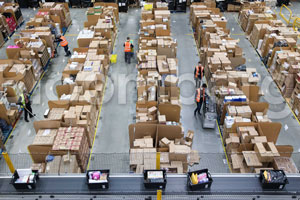Amazon Says Shipments for Independent Merchants Doubled in 2016

Amazon.com Inc. said the number of items sold for independent merchants that use its logistics service more than doubled to 2 billion last year, evidence the online retailer’s stepped-up investments in warehouses are paying off with expansion into new areas like fashion and household goods.
The world’s biggest e-commerce company has differentiated itself by offering fast, free delivery of items from its vast network of shipping hubs where inventory is stored close to customers. Fulfillment by Amazon, its logistics service, lets merchants send goods to Amazon warehouses and pay a fee for packing and shipping online orders to customers.
The number of merchants using the service increased 70% in 2016, Amazon said Jan. 4 in a statement. Getting access to Amazon Prime members, the company’s most loyal shoppers who pay $99 a year for free delivery as well as video and music streaming, is a big reason vendors want to store and sell their goods using Amazon’s website and facilities.
The growth shows that the combination of abundant inventory with quick delivery that Amazon used to win market share in books and electronics is working in new categories such as clothing and kitchen items, said John Blackledge, an analyst at Cowen & Co.
“The infrastructure they’ve built and keep adding to is a big advantage over other companies,” Blackledge said. “No one else can do what they are doing, offer so much and get it to you so quickly.”
Amazon CEO Jeff Bezos, in a letter to shareholders, highlighted Fulfillment by Amazon as a key growth driver that propelled his Seattle-based company in 2015 to more than $100 billion in sales for the first time. Amazon is projected to report that revenue increased 28% to $137 billion in 2016, according to analysts’ estimates compiled by Bloomberg.
In addition to new categories, Amazon is increasing its growth rate by expanding overseas. Outside of the United States, sales volume through Fulfillment by Amazon increased more than 80% last year. Amazon added a logistics service in Europe that lets merchants send goods to one Amazon hub and the company distributes the items to warehouses close to customers in the United Kingdom, Germany, France, Spain, Italy, Poland and the Czech Republic.
The rapid growth has a big price tag. Warehouse capacity issues and the cost of new facilities helped increase Amazon’s spending on order fulfillment 34% in the third quarter, causing it to miss analysts’ profit projections.

